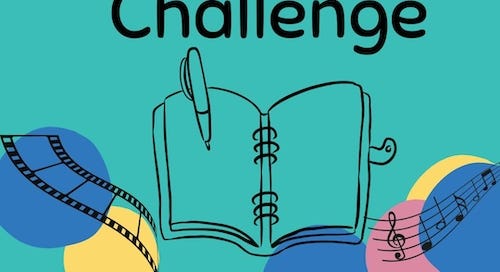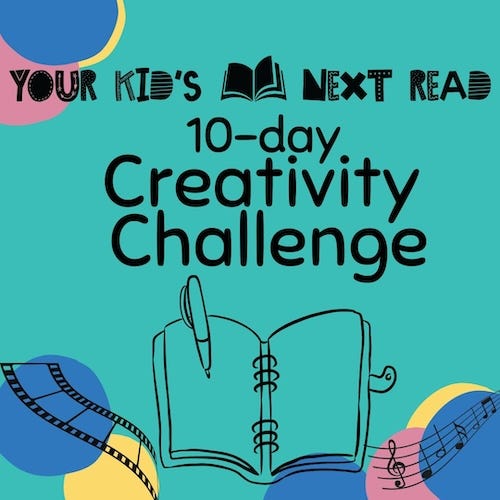I’m not a fan of New Year’s Resolutions. I’m not sure if it’s the 20+ years I spent writing ‘New Year, New You’ articles for magazines or newspapers, or the fact that every psychologist I spoke to for those articles had just one message – ‘Resolutions Don’t Work’ – but I tend to steer clear of any bombastic promises on 1 January.
Which is not to say that I don’t get halfway through January and start to think about what I might do differently this year.
When my boys were young and still at home, we’d be in that no-man’s land of the school holidays where the Christmas tree was packed away, everyone was sunburnt and it wasn’t yet time to go and buy school shoes because, no doubt, their feet would grow two sizes before 1 February… that’s when my mind would turn to looking for ways to make them think differently.
And so here we are, and I’m thinking you’ve probably hit exactly the same points I invariably do.
So, given that ‘creative thinking’ is one of the biggest ‘buzzphrases’ thrown about in regards to kids these days (along with ‘critical thinking’ and ‘screentime’) I’ve put together a 10-day Creativity Challenge.
It’s perfect for these last few weeks of the school holidays – but you can use it any time (and every time you do it, it will be different). And it’s not just for kids.
ABOUT THE CREATIVE CHALLENGE
I’ve created a simple overview PDF for the kids (write on, doodle on, tick off or generally use as they wish), and backed it up here with step-by-step, detailed notes for adults – in case young participants need help or more information, or in case you want to do it yourself!
And, of course, it all starts with a new notebook…
Step By Step: The YKNR 10-Day Creative Challenge
Day #1
Start a Creative Journal
Write down ONE thing you saw today that made you go WOW. It can be anything at all.
Then write down one thing that made you ask WHY?
Congratulations, you’ve started a Creative Journal. If you keep it up, you’ll never be short of an idea for a creative writing story ever again. The best story ideas come from things we’re curious about and things we’re passionate about.
You might need a new notebook for this. Writers love new notebooks. They also love doodling, experimenting with different pens, sticking in pictures, post-it notes, and postcards, and generally stuffing their journals with thoughts, quotes, ideas and anything else they can find.
Day #2
Plan a creative date
A creative date is an outing where you either go and try a new creative activity yourself (a workshop, a class) or you go and admire someone else’s. Talk to a grown-up about something you might be able to do together at the end of this challenge to celebrate finishing!
You could
•go to a movie
•visit a library or bookshop
•sign up for an art class
•go to an exhibition to see some paintings or photography or sculptures
•find an online talk by an author you like or see if there’s a book launch in your area
•plan a menu you can cook for a picnic in your own garden
The options are endless!
Day #3
Draw a leaf, create a world
Find a leaf. Any leaf will do, though, obviously a leaf that really ‘speaks’ to you is best. It can be a dried leaf, or a green leaf.
Now, draw or paint the leaf. You can do it in pen, pencil, watercolours, crayons, paints, whatever you like. Study it hard and then capture what you see.
You can do this in your journal, or on a separate piece of paper.
(Extra credit: You might like to draw a map based on the shape of your leaf, using any veins or bumps, or holes, or other interesting features on your leaf. Think about who lives there. Write a little story about them.)
Day #4
Find three words and write a poem
Choose a word – any word – from the book you’re currently reading and look it up in the dictionary. Take note of the word before it in the dictionary, and the word after it.
Now write a poem using those three words. Put it in your journal!
Remember, poetry can be just a few sentences long.
*Today's creative exercise is loosely based on an exercise from Twyla Tharp's The Creative Habit! Grown-ups might enjoy this book!
Day #5
Go for a walk
Did you know that one of the best things you can do for your creativity is to take a walk outside? Whenever I’m writing a novel and I get stuck, I don’t sit there and get grumpy, I go for a walk.
So, today is about a walk. Whether you go for a bush walk, a walk on the beach or a walk around the block, the only thing you have to do is to walk – and take notice.
Think about how you feel as you walk (hot, sweaty, happy, peaceful). Think about what you’re seeing (birds, bees, flowers, leaves, dirt, cars). Think about what you’re hearing (tweeting, cicadas, traffic, people).
When you get back, if you feel like it, get out your creative journal and write a little description of your walk. Remember all of those details you noticed.
Day #6
The feel of music
Watch an episode of Bluey – any episode you like – and listen to the music that plays in the background.
How would you describe the music (happy, sad, bouncy, gloomy)? How do you think the music adds to the feel of the story? How do you think people would dance to the music if they had to?
Write down your thoughts in your journal.
Day #7
Read like a writer
Pick up a book you love. One you've read enough times that you won't be distracted by the story.
Now read that first chapter like a writer.
What does that mean? Find out how to do it here.
Day #8
Memories and description
Find a photo of you and your family or friends when you were younger – at least three years ago – and study it. Look not just at the smiling faces, but at what’s around and behind them.
It’s amazing what we catch sight of in the background of a photo – and it’s those little details that can bring a whole world to life when you’re writing a story.
In your journal, write a one paragraph description of the setting of your photo.
Day #9
Choose a prompt
Choose one of the prompts below and then respond to it in your favourite creative form. You could write a story (or poem or song), draw a picture (or paint or collage), create a comic (or a short film or a dance) or…your choice.
• This couldn’t be happening!
• There was a knock at the door…
• It was the most beautiful place I’d ever seen.
• A chill ran up my spine as I realised someone was watching me.
• In the cold, clear moonlight the beach looked empty, but…
• A small, white note affixed to the top of the large, black box read ‘Caution: may bite’
Of course, you don’t have to stop at one…
Day #10
Read your journal
How many ‘wows’ and ‘whys’ do you have? What have you doodled in the margins? Have you collected pictures or postcards? Is there a description you love or a drawing?
Then congratulations, you have successfully completed the YKNR 10-Day Creative Challenge and can reward yourself with that creative date you planned on day two.
And then, well, we hope you’ll continue to collect the ideas and inspiration you’re teaching yourself to see, hear, feel and know.
Because creativity is like any muscle.
The more you use it, the more you’ll have to use.
RULES OF THE YKNR CREATIVE CHALLENGE
There are only three main rules for kids:
• It’s not homework – no-one is marking what you do, judging what you do, or, in fact, even looking at what you do if you don’t want them to
• It doesn’t have to be perfect. There is no such thing. Whatever your first response is, or your first attempt, that’s the best one. See Rule 1.
• You have to try everything. There is no room for ‘I can’t draw, I’m not doing that’ answers here. Give everything a go. The point of creativity is that it’s unexpected. Your mind opens up in mysterious ways if you allow it to do so. See Rule 1, and Rule 2.
Ready?
Download your PDF and get started!
This post was created for Your Kid’s Next Read by Allison Tait.
Writing as A.L. Tait, Allison is the author of three epic adventure fantasy series for readers 9+: THE MAPMAKER CHRONICLES, THE ATEBAN CIPHER, and THE MAVEN & REEVE MYSTERIES.
Her first contemporary middle-grade novel THE FIRST SUMMER OF CALLIE McGEE is out now. Find out more here.
For more writing and creativity tips for kids aged 9-14, check out Allison’s Creative Writing Quest for Kids, an online course to help develop their skills and confidence.
Are you an educator? As a paid subscriber to the YKNR newsletter, you have our permission to reproduce this post for school or classroom purposes (eg: newsletter or handout). The following credit must appear with the material.
”This challenge was created by Allison Tait from the Your Kid’s Next Read team. Find out more at yourkidsnextread.com”






